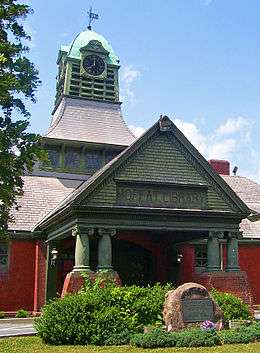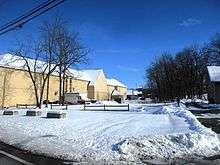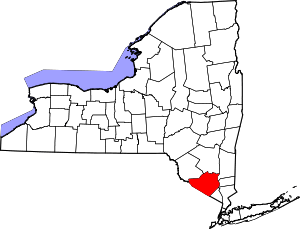Washingtonville, New York
| Washingtonville, New York | |
|---|---|
| Village | |
|
Downtown Washingtonville | |
 Location in Orange County and the state of New York. | |
 Washingtonville, New York Location within the state of New York | |
| Coordinates: 41°26′N 74°10′W / 41.433°N 74.167°WCoordinates: 41°26′N 74°10′W / 41.433°N 74.167°W | |
| Country | United States |
| State | New York |
| County | Orange |
| Area | |
| • Total | 2.5 sq mi (6.6 km2) |
| • Land | 2.5 sq mi (6.6 km2) |
| • Water | 0.0 sq mi (0.0 km2) |
| Elevation | 305 ft (93 m) |
| Population (2000) | |
| • Total | 5,899 |
| • Density | 2,359.6/sq mi (893.8/km2) |
| Time zone | Eastern (EST) (UTC-5) |
| • Summer (DST) | EDT (UTC-4) |
| ZIP code | 10992 |
| Area code(s) | 845 |
| FIPS code | 36-78465[1] |
| GNIS feature ID | 0968876[2] |
Washingtonville is a village in Orange County, New York, United States. The population was 5,899 at the 2010 census. It is part of the Poughkeepsie–Newburgh–Middletown, NY Metropolitan Statistical Area as well as the larger New York–Newark–Bridgeport, NY-NJ-CT-PA Combined Statistical Area. The village is named in honor of George Washington.
The Village of Washingtonville is within the Town of Blooming Grove.
History
Washingtonville was first settled in 1731. The village maintained a slow but steady growth during the second half of the 18th century. In 1809, John Jaques, a boot and shoemaker, set up his shop in this tiny settlement of nine houses, then known as "Little York." Jaques would later establish Brotherhood Winery, the oldest continuously operating winery in the United States, in 1839.
In its earlier years, Washingtonville was called "Matthews Field," even before it became known as Little York. A part of the Rip Van Dam patent, it was sold to Vincent Matthews in 1721. Matthews was the second settler of the region, although the first white settler. Its earliest known inhabitant was an Indian by the name of Moringamus, whose wigwam or tepee was once pitched in back of where the Coleman bottled-gas plant is located now.

Samuel Moffat built a trading post on the village square in 1811 at the junction of the New Windsor and Blooming Grove Turnpike with the Goshen Road (His son David later endowed Moffat Library on the spot). The hamlet began to prosper with a tannery, grist and plaster mills. A hotel was needed and Samuel Moffat built his Washington Tavern in 1818. The same year Samuel and John Jaques bestowed the village with a new name, Washingtonville, in honor of the late general and first president of the United States, whom it was said came through and watered his horse at the trough which had been located under the big Elm tree in the center of the village.
Washingtonville grew after the New York, Lake Erie and Western Railway built its branch through the village in 1850. Even though the railway tracks have been removed, the remains of the railroad building are located behind the present day Agway Store. Incorporated in 1895, the village had become an important dairying center where two creameries, Borden's (presently used as a bus garage for the Washingtonville Central School District) and the Farmers Cooperative Market (South Street), several groceries, a bank, feed and lumber dealers, wagon shops, furniture makers and a hub shop all prospered. Its greatest growth in that time occurred in the seventh and eighth decades.
C.R. Shons opened up a cooperative on Depot Street, where the old red building still stands, and also had a large orchard on Goshen Avenue. Thomas Fulton's grist mill, now the site of Agway, was destroyed by fire in the early 1900s. Hugh Lunney had his slaughter house on Goshen Avenue, near where the Spear Printing Company plant was, and also had a large ice house beside the point to Coopers Creek, harvesting ice for commercial use from the pond in the winter.
Borden's Creamery maintained a bottling plant and its refrigerator cars, loaded with milk, were shipped to Greycourt (Harriman) on either the Erie freight or passenger runs. This firm cut its ice from the small pond south of its creamery, storing it in the ice house on the east side of the plant.
Recent weather events
From the evening of Sunday, April 15 until Tuesday, April 17, 2007, the nearby Moodna Creek overflowed into downtown Washingtonville. Nearby May's Field resembled a lake with 3–4 feet of water. A similar flooding occurred in 1955. These floodings were the results of a powerful Nor'easter that slammed the Northeastern U.S. Videos of the flooding were featured on the websites of WCBS-TV, Cable 6 News, and the Times Herald Record. Pictures were posted on the high school's website.[3]
On Sunday, August 28, 2011, Washingtonville was ravaged by a Category 1 hurricane. Despite being just a Category 1 storm, the hurricane caused widespread flooding in the town, initiating a mandatory evacuation. The flooding was mostly due to the town being situated in a basin of the Moodna Creek, which surrounds the town. Shelters for the affected were set up in a nearby elementary school and gym.
On Saturday, October 29, 2011, Washingtonville was also ravaged by an unexpected early snow storm. Up to a foot of heavy wet snow fell on the town. The major problem is that the leaves had not fallen off the trees yet, so limbs and branches had fallen blocking most roads including State Route 94. Over 90% of residents were left without power.
Notable residents of Washingtonville
Steve Cahillane, president of Coca Cola Enterprises USA attended Washingtonville High School and graduated in 1983.[4]
Brian Cashman, general manager of the New York Yankees, lived in Washingtonville until high school.
Emily DiDonato, model for Victoria's Secret, Maybelline, Giorgio Armani, etc.
Tony Gilroy, writer and director, grew up in what is now South Blooming Grove and attended Washingtonville High School. His film credits include The Bourne Trilogy (screenwriter) and Michael Clayton (writer/director).
Eddie Hawkins, 1980 graduate of Washingtonville High School, two-time National Coaches All-American and two-time Parade Magazine high school All-American, in 1984 he became the first native U.S. black soccer player to earn a cap for the U.S. National team.
James Mangold, a director and screenwriter, graduated from Washingtonville High School. His notable works include 3:10 to Yuma, Knight and Day and Walk the Line. His movie Cop Land is based on Washingtonville and its many NYPD residents.
Scott Pioli, General Manager, Kansas City Chiefs graduated from Washingtonville High School in 1983.
Brittany Taylor member of the United States women's national soccer team and American professional soccer player with Sky Blue FC of the Women's Professional Soccer league.
Washingtonville Central School District
Washingtonville Central School District is made up of five schools; Washingtonville High School, Washingtonville Middle School, Little Britain Elementary School, Taft Elementary School, and Round Hill Elementary School. Completed in 1933, the current Washingtonville Middle School housed all the grades of Kindergarten through 12th grade. Little Britain was adjacent to Stewart Air Force Base, and was only for children whose parents were in the military. The air base has long since been closed, but military personnel are still housed in new housing units located just west of Little Brittain Elementary. The high school has undergone several renovations, the last completed in 2010. In addition to adding on classrooms, three computer labs were also added, including a Mac Lab.
Geography

Washingtonville is located at 41°26′N 74°10′W / 41.433°N 74.167°W (41.43, -74.16).[5]
According to the United States Census Bureau, the village has a total area of 2.5 square miles (6.5 km2), all of it land.
Washingtonville is at the junction of highways NY-94 and NY-208.
Communications
Washingtonville has the 496 and 497 telephone exchange within the 845 area code and the Postal ("ZIP") Code 10992.
Demographics
| Historical population | |||
|---|---|---|---|
| Census | Pop. | %± | |
| 1890 | 691 | — | |
| 1900 | 667 | −3.5% | |
| 1910 | 631 | −5.4% | |
| 1920 | 631 | 0.0% | |
| 1930 | 663 | 5.1% | |
| 1940 | 801 | 20.8% | |
| 1950 | 823 | 2.7% | |
| 1960 | 1,178 | 43.1% | |
| 1970 | 1,887 | 60.2% | |
| 1980 | 2,380 | 26.1% | |
| 1990 | 4,906 | 106.1% | |
| 2000 | 5,851 | 19.3% | |
| 2010 | 5,899 | 0.8% | |
| Est. 2015 | 5,788 | [6] | −1.9% |
As of the census[1] of 2010, there were 5,899 people, 2,177 households, and 1,514 families residing in the village. The population density was 2,300.2 people per square mile (889.4/km²). There were 2,044 housing units at an average density of 803.6 per square mile (310.7/km²). The racial makeup of the village was 80.30% White, 8.22% African American, 0.46% Native American, 2.51% Asian, 6.15% from other races, and 2.36% from two or more races. Hispanic or Latino of any race were 18.27% of the population.
There were 2,177 households out of which 35.9% had children under the age of 18 living with them, 55.5% were married couples living together, 17.4% had a female householder with no husband present, 9.2% had a male householder with no wife present and 30.5% were non-families. 26.6% of all households were made up of individuals and 15.4% had someone living alone who was 65 years of age or older. The average household size was 2.71 and the average family size was 3.32.
In the village the population was spread out with 25.2% under the age of 18, 5.7% from 20 to 24, 22.7% from 25 to 44, 30.4% from 45 to 64, and 13.3% who were 65 years of age or older. The median age was 41.1 years. For every 100 females there were 93.9 males. For every 100 females age 18 and over, there were 90.5 males.
The median income for a household in the village was $62,568, and the median income for a family was $69,145. Males had a median income of $57,552 versus $39,958 for females. The per capita income for the village was $24,036. About 1.6% of families and 3.7% of the population were below the poverty line, including 2.9% of those under age 18 and 12.0% of those age 65 or over.
References
- 1 2 "American FactFinder". United States Census Bureau. Retrieved 2008-01-31.
- ↑ "US Board on Geographic Names". United States Geological Survey. 2007-10-25. Retrieved 2008-01-31.
- ↑ Pictures of the Local Flooding (Washingtonville Central School District)
- ↑ Sullivan, John (28 June 2009). "Coca-Cola exec says Washingtonville taught him how to succeed". Recordonline.com. Retrieved 10 March 2010.
- ↑ "US Gazetteer files: 2010, 2000, and 1990". United States Census Bureau. 2011-02-12. Retrieved 2011-04-23.
- ↑ "Annual Estimates of the Resident Population for Incorporated Places: April 1, 2010 to July 1, 2015". Retrieved July 2, 2016.
- ↑ "Census of Population and Housing". Census.gov. Retrieved June 4, 2015.
External links
| Wikimedia Commons has media related to Washingtonville, New York. |
